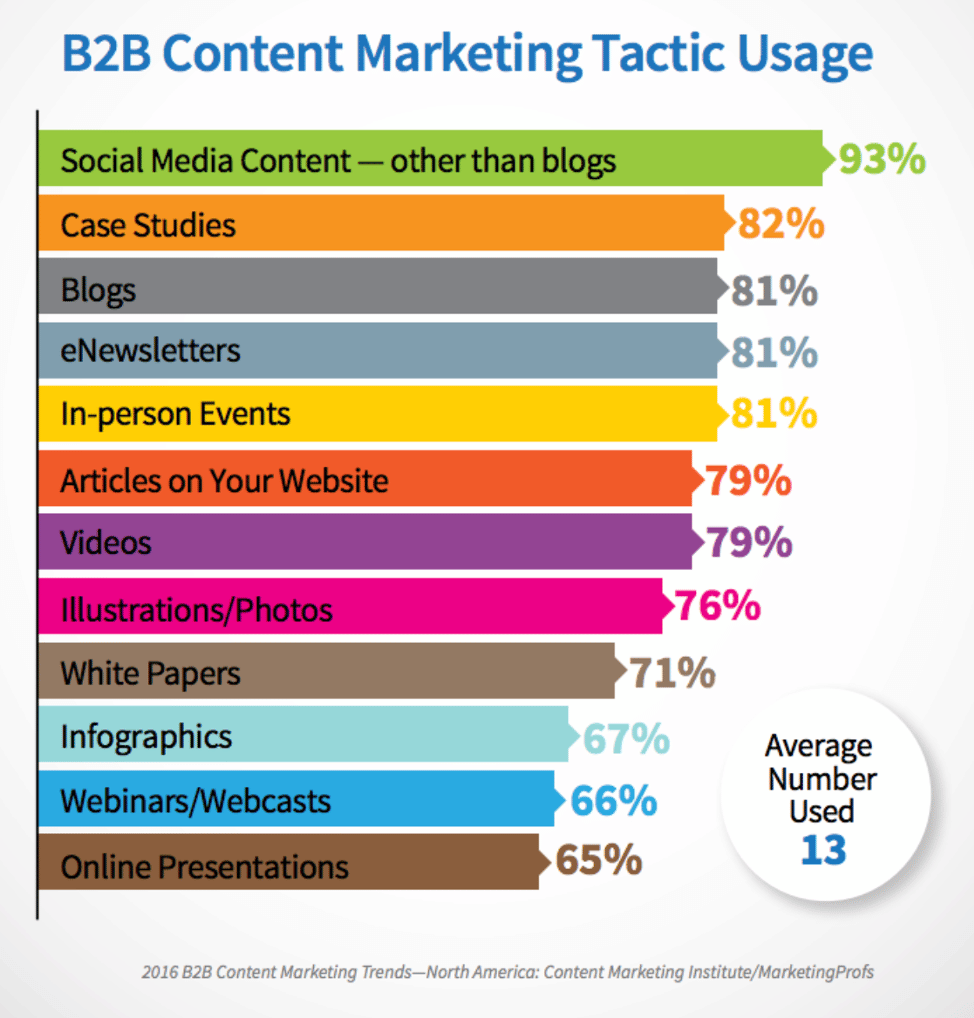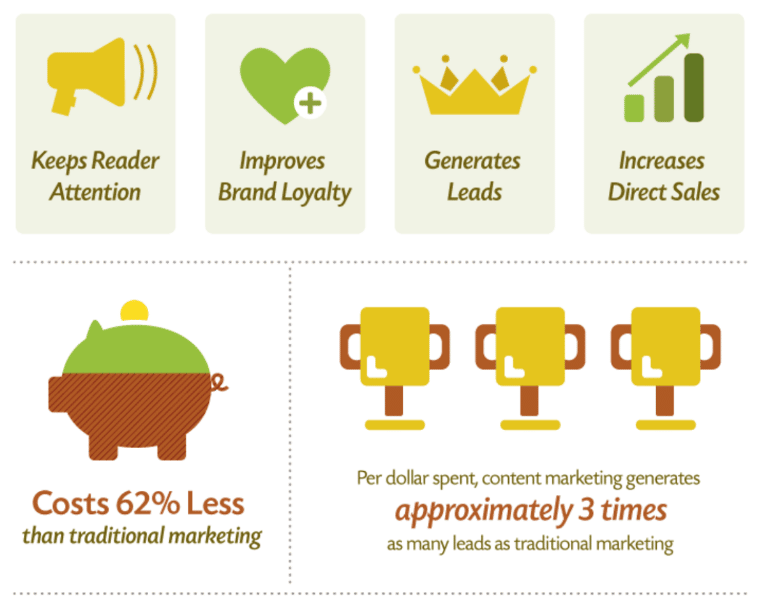Content marketing is nothing new.
It has only grown bigger. In fact, companies that invest in content marketing enjoy six times more conversions than companies that don’t.
So, if you haven’t got your content marketing strategy up and running yet, now is the best time to start. But how do you begin? How do you differentiate between what works and what doesn’t? How can you measure your success (or failure)?
In this guide, you will learn why you should prioritize a content marketing strategy, give a step-by-step on how to start, and discuss how to measure your progress.
1. Content Marketing Guarantees Huge Savings and Attractive ROI
With content marketing, you spend less but earn more. This sounds hard to believe, but look at these two facts:
- Content marketing costs 62% less than other types of marketing
- But generates as many as three times more leads.
Content marketing also:
Why? Simply because producing compelling content isn’t like paying for ads. What you need is time and talent, not so much big bucks.
What’s more, quality content presents you as an expert in your industry. When potential clients recognize you as one who knows what you’re talking about, they’re more likely to buy from you.
2. Almost Every B2B Marketer in the U.S. Recognizes Content Marketing as a Powerful Tool
88% of American B2B marketers now use content marketing. This is because of how user behavior has changed in recent years.
For example, 30% of all internet users now use ad blockers. Imagine the frustration of going the extra mile to design and pay for ads that never even reach your prospects.
Since buyer behavior today is different from what it was 100 years ago, it’s important for marketers to change how they reach out to prospects. In this new age, providing real value to people converts them faster than spamming them with ads.
3. Content Marketing Speaks to Consumers’ Needs at Every Stage of the Sales Funnel
New visitors don’t buy your product the first time they visit your site. First, they look around. They read your blog. They think about whether or not they’ll benefit from what you’re offering.
This means that your visitors will go through several stages in the sales funnel. They’ll become more aware of your business. They’ll learn to trust you. Only then will they consider buying from you.
The great thing about content marketing is that it provides value to potential clients at every stage of the funnel. In the awareness level, they can read your blog; in the consideration stage, they can read your emails and newsletters … until they reach the decision stage and become loyal clients.
4. Buying Decisions Are Often Based on Effective Content
Nowadays, prospective clients use content to reach a decision. They want to learn whether a product really works before they buy it. And they want hard facts and statistics to prove it.
This is where effective content comes in. For instance, a company can offer business white papers—i.e. in-depth guides that workably solve complex problems—to prospects.
Do they work? Certainly. In fact, 78% of buyers read business white papers before purchasing a product.
5. Good Content Forges Lasting Relationships with Buyers
Forge a strong relationship with your customers post-sale by adding more value.
One effective way to create lasting relationships with buyers is through engaging content. When you continue to give buyers value, you increase the likelihood that they’ll buy from you again. Also, they’re more likely to recommend your brand to others.
So, since content marketing actually works, the next question is how to do it effectively. Here’s your comprehensive guide.
A Step-by-Step Guide to Effective Content Marketing Strategy
There are 1.74 billion websites today. How can your content stand out?
Follow this guide for content marketing that’ll put you on top of your competitors in the long run.
Step 1: Determine Your Goals
Before figuring out what to write or making a content calendar, you need to first be clear on your goals. What do you hope to achieve with your content marketing strategy?
The key is to divide your goal into two parts. The first is to identify the primary and secondary benefits your audience will get from your content. The second is the benefit you will get when they read your content.
Here are three possible benefits your audience could get when they read your content:
- They’ll learn an industry insider’s secrets.
- They’ll get expert advice on how to achieve their goals.
- They’ll be inspired by actionable tips to make their life (or business) better.
On the other hand, three benefits you could get when readers engage with your content are:
- more quality leads
- greater influence with readers so you’re seen as an expert in your industry
- increased sales through your content.
Once you set your goals and the accruing benefits to both you and your readers, you can move on to the next step.
Step 2: Get Into Your Audience’s Shoes
Writing to a generic persona never works in content marketing. When you try to appeal to everybody, you end up appealing to nobody.
This is why knowing your audience is key. You want to find out who’s reading your content, and why. You want to dig deep into their minds and discover their pain points, questions, and desires. Only when you know your audience will you be able to speak directly to them and gain their attention.
So how do you figure out who your audience is? Here are three ways.
- Use Google Analytics. To know how to talk to your audience, you’ll want to know important information like their age, gender, and location. You’ll want to find out their level of education, income, interests, and so on.
A good tool for gathering the right information is Google Analytics, which has both a free basic version and a paid version you can get with Microsoft Office 365.
Setting up a free Google Analytics account is simple. All you need to create your account is your new account name, your website’s URL, and your time zone. Once your account is ready, click Audience in the toolbar to the left of your screen. Under Audience, you’ll be able to get data on your visitors’ demographics, interests, and behavior. You can also find out how much time they spend on your site, their bounce rate, and how many pages they click through.
- Visit Reddit. Reddit isn’t called the front page of the internet for nothing. With over 330 million monthly active users, it’s as large as Twitter and larger than Pinterest and Snapchat.
What does this mean to you as a marketer? That’s right: With so many people on Reddit, it’ll be easy to find a host of your consumers and learn what they’re talking about.
It’s not hard to do. Simply go on the platform and use Reddit’s search tool to look up your keywords. You’ll be presented with a number of subreddits related to the keywords you use.
Focus on the subreddits showing the most up votes and engagement. For instance, if you search using the keywords “real estate,” the subreddit with the highest engagement is from a homeowner who purchased a house in the line of fire of a shooting range. From this discussion, you learn about the frustrations, fears, and confusion of homeowners. If you deal with them in a blog, your chances of getting engagements are high.
- Spend Time on Quora. This is where people go when they need questions answered, which makes it a great place to go when you want to find out what your audience is thinking about.
It’s simple. Go on Quora and type in a keyword. You’ll be presented with questions from different users. Choose the ones with the most engagements. These are the questions that mean something to your audience. Also, pay attention to how your audience speaks. When you write content users can relate to, in both content and tone, you’ll easily capture their attention.
Step 3: Discover the Secret of USP
As mentioned above, there are 1.74 billion websites today. In the sea of online content, how do you attract attention to your brand?
The answer is to find and bring your USP (unique selling proposition) to the forefront. Answer these questions: “What makes your content unique from your competitors’? Why should they choose to read your blogs, and not your competitors’?”
Finding your USP can take work, but it’s entirely doable. All you need is to carry out comprehensive research of your market. Go over your competitors’ content. Look for gaps in what they provide. Make a list of information that should be there but isn’t. Learn the pain points of their audiences and what makes them frustrated with your competitors.
When you learn what users are looking for but can’t find with your competitors, you’ve found your USP.
Step 4: Determine What Type of Content You’ll Create
Content marketing isn’t just posting a blog or two every week. In fact, you’ll be surprised at how many types of content you can use to boost your brand. Here are some examples of content that works:
- Videos
- Case studies
- Infographics
- White papers
- eBooks
- Interviews
- Checklists

The secret is finding out what kind of content to produce for each stage of the buying process.
Most of the time, your audience won’t buy your product the first time they land on your website. They’ll go through your content first. They’ll click away, and think about it. They’ll spend time considering. Then, they’ll come up with a decision.
Basically, your buyers go through three stages. Stage One is where they learn about your product. They think about it in Stage Two. And in Stage Three, they decide. What you need to do is provide them with content at every stage of the journey, with the aim of getting them to buy what you offer.
Here’s how:
- Stage One: Awareness. Your visitors don’t necessarily visit your site because they want to buy something from you. Maybe they’re looking for an answer to a question. Or some advice to help them solve a problem. Although the chances that they’ll buy from you when they first land on your site are almost 0%, you get one positive outcome from the visit: awareness.
So what content do you create for buyers who are in this stage? Three stand out: blogs, how-to videos, and educational webinars.
- Stage Two: Consideration. No matter how good your awareness content is, it doesn’t guarantee that your prospect will buy your product. That’s why you need to guide them towards the sale. To do this, you need content for the consideration stage of the buying journey.
Here are three types that work excellently: eBooks, case studies, and demo videos.
Your main goal is to show prospects that they can trust you. Show your tone, good repute, and your unique way of presenting your expertise. If your content is compelling at this stage, your prospect will likely get into the next stage.
- Stage Three: Decision. Now that a prospect is in the final stage of the buying process, you can sit back and congratulate yourself. Right?
Not so fast.
Because how do you know that when they buys, they’ll buy from you?
This is why you still need compelling content for the last stage of the buying process. You need to give a prospect the extra nudge that’ll get them to buy.
Here are three forms of content that work: Free trials, landing pages with strong call-to-action, and discount coupons.
Step 5: Create Your Content
This is the part where you actually start writing. Based on the information you’ve gathered from Steps 1 to 4, you already have a clear idea of what to write.
But there are other things to keep in mind as you craft your content.
- Your Brand’s Voice. Think of your brand as a person with unique characteristics. Then, write as this person. Are you formal? Casual? Humorous? Creative? Serious? Or a mixture of more than one personality? Find your distinct tone of voice and be consistent with it.
- Proper Scheduling of Content. If you plan to produce consistent content, you’ll need a content calendar so you don’t feel overwhelmed trying to figure out what to write at the last minute. If you have a writing team, an editorial calendar like the one CoSchedule offers is a great idea. Do the research on what to write, and use the calendar to assign due dates for each piece of content.
- Optimizing the Right Keywords for Your Content. Although the main focus when you write content should be value, you shouldn’t underestimate the importance of keywords. Good keyword research will not only give you better chances of ranking on Google; it’ll also keep you on track with your topic flow.
Here are some tools you can use for keyword research: Ubbersuggest, Google Analytics, and Ahrefs.
Step 6: Measure the Success of Your Content Marketing
Content marketers are often confused on how to measure success in content marketing. Is it social shares? Unique page visits? Revenue? Traffic?
Others say it’s impossible to measure content marketing success at all. For instance, it’s impossible to gauge which particular piece of content sealed the deal for a prospect and compelled them to buy a product.
So is it possible to measure content marketing success? And how do you do it?
The answer is simple. All you need to find is the purpose of each piece of content you produce. For instance, you write a blog to lead your prospect to your website. If the prospect clicks your link and visits your site, your blog has achieved its purpose.
Define the purpose of each piece of content you write. Is it to lead your prospects to your website? Make them give you their email address? Click through to another page on your site? Buy something? If your content inspires action, consider it successful.
Real-Life Examples of Content Marketing that Worked
Of course, it’s not easy to come up with unique and compelling content from scratch. To help you, we’ve come up with three inspiring examples of content marketing that generated massive success.
1. Rip Curl’s Online Publication
Rip Curl is a company selling surfing gear and apparel. To boost sales, it created a publication called The Search.
The Search is unique: In every post, it tells the story of expert surfers hunting down unusual waves. It features a skillful play of words, stunning photos, and exciting stories every surfer dreams about living.
The result? The Search now has over 2 million Facebook followers. You can just imagine the boost in sales this content marketing success has achieved for Rip Curl!
What you can learn: Content marketing is storytelling. The more compelling your stories, the more success you’ll enjoy from your campaigns.
2. Buffer’s Blog
If you’ve heard of Buffer, you know it’s a program designed to help you grow your brand on social media. With 4 million users, Buffer is a hugely successful brand. If you’re wondering how they did it, just look at their blog.
Buffer’s blog focuses on one thing: giving readers value. It reveals insider secrets. It publishes unique collections of facts. It gives data-backed advice. It’s no wonder 4 million people now trust Buffer as their go-to social media success platform.
What you can learn: For every piece of content you produce, ask this one question: “What takeaway will visitors get from reading this?”
3. LinkedIn
LinkedIn created its own eBook featuring a unique and interesting topic: how LinkedIn uses LinkedIn to market itself. If the unusual topic doesn’t compel you to download the book, the stats featured on its landing page will.
What you can learn: Don’t be afraid to do something unusual. There’s no limit to what you can do with a value-packed eBook and a landing page filled with reliable stats.
Wrapping Up
Content marketing isn’t a walk in the park. It’s not something you take on as a side hobby. Although it takes hard work, creativity, and patience, you’ll be sure to get clear results in less time than it takes to save for pricey ads.
Follow these steps one by one and inject passion and persistence into what you’re doing. In a little while, you’ll be surprised to find your brand growing in leaps and bounds.







7 Responses